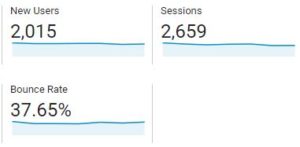If you have been struggling to increase search traffic to your site because people simply aren’t staying on your site once they get there, you bounce rate is probably too high. That old saying “I’m like Teflon, nothing sticks to me!” is not the mindset you want when it comes to people coming to your landing page.
What is bounce rate?

Bounce rate is a metric that measures the percentage of people who land on your website and do completely nothing on the page they entered. In other words, they are not sticking to your site. Which means that they are not clicking on a menu item, or anything else. They simply don’t engage with your page.
So, your bounce rate is the percentage of all users who enter and exit on the same page, without any clicks to other pages on your site.
How Google Analytics Determines Your Bounce Rate
 According to Google, Bounce Rate is single-page sessions divided by all sessions or the percentage of all sessions on your site in which users viewed only a single page and triggered only a single request to the Analytics server.
According to Google, Bounce Rate is single-page sessions divided by all sessions or the percentage of all sessions on your site in which users viewed only a single page and triggered only a single request to the Analytics server.
This means the duration of the session was 0 seconds since no further hits happened after they came to your page that would let Google Analytics calculate the length of the session.
Whether this bounce rate is a good or a bad thing depends on your mission:
Actively engage: If you want users to go through and view other pages on your site, then it’s a bad thing.
Primarily inform: Conversely, if it’s a single-page site like a blog or other sites where single-page sessions are expected then a high bounce rate is normal. And if visitors found the information that they were looking for, they simply left your page.
If you are looking more at scenario A than B, then a high bounce could mean your landing page isn’t well organized or engaging.
- One way that it might not be engaging is if you have large blocks of copy with no visual relief. If it is overwhelming and hard to digest, people often get scared away.
- Once it is easy to read, make sure the content is something that your customers want to read. Content is king. Or queen. Basically, content rules.
- Don’t forget about targeting great keywords to improve search performance. These keywords are where the high-value traffic is.
If you’re new to all this, here is a handy (and short) beginner’s video from web influencer Neil Patel on how to decrease your bounce rate:
What about exit rate?
There is still going to be an exit rate of visitors no matter what, be these visitors aren’t necessarily bouncing. The bounce rate and exit rate are two different things. The exit rate is the percentage of page views in the last session. It refers to the number of times visitors have left a site from a specified page. Still have questions? Give us a call at (517) 680-7957.
bounce rate • bounce rate percentage • decreasing bounce rate





